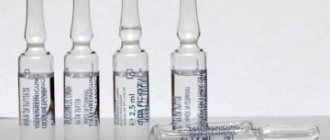Decapeptyl is a hormonal drug that is used to treat tumors and diseases of the reproductive system, as well as in in vitro fertilization (IVF). The active substance is a synthetic analogue of GnRH (gonadotropin-releasing hormone, or gonadorelin) triptorelin.
During use in the artificial insemination program, subcutaneous injections are performed (the liquid is colorless and odorless, the set includes seven syringes with needles, 1 ml of solution each). The syringe is similar to an insulin syringe, the needle is thin for painless administration of the drug.
Decapeptyl is used for IVF because of its active ingredient, which immediately after administration increases the plasma concentration of certain sex hormones. How to do the injection correctly is shown in the video below.
pharmachologic effect
This drug has a therapeutic effect due to the content of triptorelin.
This substance is similar to the synthetically produced gonadotropin-releasing hormone.
Triptorelin is several times better than its natural counterpart.
After an injection of the drug Decapeptyl, it quickly begins to influence the amount of lutein and follicle-stimulating hormones in the direction of increasing it for a short period of time.
The drug acts to increase LH and FSH levels
Tests on animals showed that the Decapeptyl solution does not have a teratogenic or mutagenic effect on cells.
In 18.7 minutes, triptorelin partially disintegrates in plasma. About 4% is excreted unchanged through urine.
Injection procedure
- take one ampoule from the box, having previously unsealed it, remove the lid from the needle;
- the syringe should be in the left hand, and in the other hand a cotton pad soaked in ethanol-96%;
- Wipe the area where the injection will be given with alcohol;
- usually choose the shoulder or stomach, changing the injection site every day;
- move the syringe to your right hand and gently insert the needle into the skin;
- squeeze out the liquid and remove the needle from the body;
- treat the injection site with a piece of cotton wool soaked in alcohol.
Indications for use
The drug Decapeptyl is used against both female and male ailments, but for the treatment of different diseases.
In men, the drug is used to eliminate the symptoms of prostate carcinoma of a hormone-dependent nature and a progressive type.
In the case of the female body, the drug in the form of a solution fights:
- Endometriosis;
- Uterine fibroids;
- Infertility.
Decapeptyl is used for in vitro fertilization and embryo transfer into the uterine cavity.
Impact on well-being
Negative consequences of using the medicine include: stress, vomiting, insomnia, loss of appetite, vaginal discharge and bleeding, decreased sexual desire, mood swings, allergies, anaphylactic shock, pain, itching.
All these symptoms can appear with the individual sensitivity of the body, long-term use, or a sudden change in dosage. In other cases it is rarely observed. The severity of the consequences depends on the cause of the side effects.
The drug does not accumulate in the body. After completing the course of therapy, all symptoms go away on their own.
Contraindications
The drug is contraindicated during pregnancy.
A general contraindication for all patients is hypersensitivity to one of the components of the drug.
Women should not use Decapeptyl solution while pregnant or breastfeeding, or if they have or are at risk of developing osteoporosis.
The drug is used with caution during IVF if the patient has polycystic disease.
For men, the main contraindication to the use of the drug is the presence of hormone-independent carcinoma in the prostate gland and castration.
Why is the drug prescribed for IVF?
For IVF, the drug can be used both during the preparation process and after embryo transfer. Before replanting, it is used during stimulation to avoid premature luteinization of the follicles. This increases the chances of successful IVF.
After transfer, only 1 injection is given, usually the next day, in order to increase the chances of the embryo attaching to the uterine wall and minimizing risks.
Side effects
Some women note that when using Decapeptyl solution, there is a delay in menstruation, but this is not the only sign of the body’s failure to accept the drug.
| No. | Organ system name | Adverse reactions |
| 1 | Genitourinary system | Urinary tract obstruction; Pain during sexual intercourse; Dryness of the vaginal mucosa; Bleeding in the uterus; Decreased potency; Gynecomastia; Reduction of testicles in size. |
| 2 | Nervous system | Paresthesia; Visual impairment |
| 3 | Digestive system | Nausea; Poor appetite Increased activity of liver transaminases; Hypercholesterolemia. |
| Musculoskeletal system | Pain syndrome in the back; Bone pain; Spinal cord compression; Muscle weakness; Myalgia; Arthralgia; Weakening of bone tissue. | |
| 4 | Local reactions | Pain in the injection area; Itching; Redness; Fever. |
| 5 | Other | Thrombophlebitis; Swelling of the lower extremities; Enlarged lymph nodes; Hair loss; Mood variability; Depressive states; Decreased libido; Frequent headaches; Poor sleep; Tides; Weight gain; Excessive sweating. |
Negative consequences
If you do everything correctly and control the entire process, then there should be no negative consequences. Uterine bleeding caused by a sharp decrease in size is rarely observed. Also, for some women, the menstrual cycle took too long to recover. But the reasons were mainly related to incorrect dosage, overdose of the drug, as well as its combination with other hormonal drugs that could not be combined.
Complications can often arise with polycystic ovaries if the number of mature follicles and the size of the ovaries themselves are not controlled. Torsion may occur if the size is too large. This is monitored using ultrasound.
Instructions for use
The drug Decapeptyl is injected subcutaneously from the front into the abdomen or intramuscularly, each time you need to inject in a different area.
| No. | Reason for using Decapeptyl solution | Dosage and conditions of administration |
| 1 | Uterine fibroids; Endometriosis; Prostate carcinoma. | For the first 7 days, 0.5 mg of Decapeptyl is used, and from the 8th - 0.1 mg once a day. Decaptil depot is used for long-term treatment: 1 injection every 28 days. |
| 2 | ECO; PE. | For a short protocol - 0.1 mg from the day of the first injection until the use of hCG. 0.1 mg three days in a row for the ultra-short protocol. |
Video about how to inject the drug into the stomach:
Decapeptyl in a long IVF protocol
A long IVF protocol involves complete artificial control over how the follicles mature. It is during this period that Decapeptyl is most often used. Injections of this drug are prescribed daily from the 3rd day of menstruation so that the woman’s body does not interfere with the maturation of eggs.
When the eggs are mature, it is important that the woman’s body does not interfere with their collection. That is, it is impossible for menstruation to occur. Decapeptyl is needed precisely to create conditions that are a bit like artificial menopause.
In addition, Decapeptyl during a long protocol helps prevent the occurrence of hyperstimulation, which would force the IVF procedure to be postponed. And in general, hyperstimulation is very harmful for a woman, and it is better to avoid this.
special instructions
Photo of the drug declaration certificate.
Due to the use of the solution, testosterone increases in men, which can provoke a slight exacerbation of the disease.
Women should not use hormonal contraceptives during treatment with this drug.
While taking the Decapeptyl solution, you should not have periods; if they occur regularly, you should consult a doctor.
Price of the drug in the pharmacy
A package containing 7 ampoules of 1 mg each costs an average of 2500-2800 rubles . It all depends on the city or pharmacy in which the product is purchased. If you order online, you may have to pay extra for shipping.
In many medical centers where IVF is performed, you can also purchase this drug or simply pay for the injection itself, which will include the price of Decapeptyl.
Be sure to read how to do IVF for free under a quota from the Ministry of Health
What dangers does gestational diabetes mellitus (GDM) pose during pregnancy can be found out here
5 reasons for unsuccessful IVF: https://hochu-detey.ru/reproduct/eko/prichiny-neudachnogo-ehko.html
Reviews from doctors
Petrov Boris Artemyevich, gynecologist : “Ailments of the female reproductive system in the form of tumors have begun to occur more often. It’s good that they produce drugs such as Decapeptyl. It helps many women regain not only their health, but also their self-confidence.”
Kulesha Zinaida Sergeevna, gynecologist-surgeon : “My patients with uterine fibroids often lose heart, thinking that nothing can help them. Thanks to Decapeptyl, we remove the tumor using laparoscopy, which subsequently allows us to lead a normal sex life.”
Composition and release form
| Injection | 1 syringe |
| triptorelin acetate | 105 mcg (equivalent to 95.6 mcg triptorelin) |
| triptorelin acetate | 525 mcg (equivalent to 478.1 mcg triptorelin) |
| Excipients: | |
| sodium chloride | |
| glacial acetic acid | |
| water for injections |
Decapeptyl contains the active substance triptorelin acetate. An analogue of the drug is Diferelin. The mechanism of action of the drug is reversible depletion of the pituitary gland. The administration of the drugs causes an increase in the secretion of gonadotropic hormones in the pituitary gland (FSH, LH), then the synthesis of hormones decreases.
This effect of the drug allows it to be used in the treatment of hormone-dependent neoplasms of the genital organs. Decapeptyl has no teratogenic effect, does not cause mutations, and is completely eliminated from the body within 24 hours.
Embryo culture media
Before the embryo is transplanted into the uterus, it is raised under special conditions in an incubator. Each stage of IVF takes place in its own environment, which is selected taking into account the physiology of the female body. They try to repeat the processes that occur in the fallopian tubes as the egg moves through them. The embryo culture media differ in their characteristics:
- Media for sequential cultivation up to 3 days. The composition has been proven to increase the frequency of fragmentation and has an optimal pH level of 7.2, which helps to improve the development of the embryo. As a result, a larger quantity is suitable for replanting. Such media consist of non-essential amino acids, albumin, vitamins, calcium lactate, and practically do not contain glucose.
- Culture media up to day 5 contains amino acids, large amounts of glucose, phosphate, taurine and vitamins. The concentration of substances takes into account the physiological needs of the blastocyst.
- Uniform media are suitable for all stages of IVF - from fertilization to cultivation and embryo transfer. The likelihood of implantation is increased by the addition of hyaluronic acid.
USEFUL INFORMATION: Is it possible to get pregnant without a man, how does conception occur?
Stages of embryo development
Changes occur daily in a fertilized egg.
On day 1, it is assessed whether fertilization has occurred. An egg is considered fertilized if 2 pronuclei are distinguishable in it - the genetic material of the parents. At this stage, unsuitable material is rejected:
- If fertilization has taken place with two or three sperm;
- Immature eggs in which fertilization has not occurred.
The transfer is not performed during this period for two reasons:
- The egg should be in the fallopian tube, not in the uterus.
- There are no criteria to determine a viable quality egg.
On day 2, the egg fragments to form two blastomeres. Experts evaluate the shape of blastomeres and the number of nuclear-free parts. The more there are, the lower the cell’s potential for further development. Transplantation on this day is performed only when 1-2 eggs are received.
On day 3, up to 8 blastomeres are formed. If there are any anomalies, then the development of the embryo stops itself. At this point, replanting is possible, but the evaluation criteria are unreliable in determining viability.
On day 4, 16 blastomeres form a morula, in which a cavity gradually forms. Under physiological conditions, it enters the uterus. Transplantation on this day gives good results in terms of embryo survival.
On days 5-6, the cavity inside the morula increases to half its volume, it enters the blastocyst stage. The cells inside it are arranged in layers that will give rise to the body of the embryo and the membranes with the placenta. The blastocyst is freed from the shiny membrane that covered it outside. From this moment on, it is able to attach to the wall of the uterus.
Embryo transfer on days 5-6 increases the number of implanted embryos and successful pregnancies. According to statistics, every second embryo survives. This makes it possible to implant a smaller number of blastocysts, which reduces the likelihood of multiple pregnancies.
Cultivation protocols in IVF
Data on cell development by day are entered in the form of special alphanumeric designations into the embryo cultivation protocol. The interpretation reflects the state of the cells, blastocysts. The following indicators are assessed:
- number of blastomeres by day, the day of fertilization is considered zero;
- the percentage of fragmentation is indicated by letters;
- The size of the blastocyst is determined by the volume of the cavity and assigned a number from 1 to 6;
- two letters indicate the quality of the cell mass of the blastocyst, the first - the inner layer, the second - the trophoblast;
The quality of the cells is determined by class, where 1(A) is excellent, and the last 4(D) is unsatisfactory. Class 4 embryos are not used for transfer and cryopreservation.
When is cultivation not possible?
There are no contraindications for embryo cultivation, but if the following factors are present, it is not recommended to resort to IVF without prior treatment:
- myoma;
- malignant tumors;
- inflammatory or infectious processes;
- exacerbation of chronic diseases;
- absence of a uterus.
The method of growing embryos increases the pregnancy rate. When choosing a culture period, the doctor should take into account the condition of the individual patient.
Yulia Shevchenko, obstetrician-gynecologist, especially for Mirmam.pro










